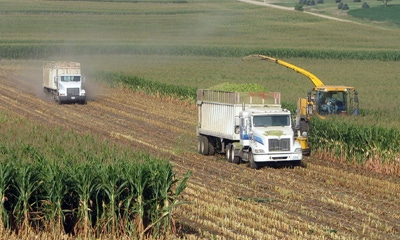July 1, 2016

An age-old feed — corn silage — is gaining new interest among researchers, nutritionists and Extension staff in Nebraska, Iowa and Kansas.
"Corn silage appears to be very economical in beef growing and finishing situations, and we know many people use it," says Galen Erickson, beef feedlot specialist at the University of Nebraska-Lincoln. "If it's going to be used, however, it's important to know the specifics about types, storage and pricing."

QUALITY AT HARVEST: "The major hurdle to overall quality of the silage is the quality of the material at harvest," according to Robert Charley of Lallemand. Corn should be cut at the right stage — 1/2 to 2/3 of milk line, then chopped, processed and inoculated properly and put into the pile as quickly as possible.
In mid-June, Erickson spearheaded a Silage for Beef Cattle Conference at UNL's Agriculture Research and Development Center near Mead, attended by several hundred people and sponsored by Lallemand Animal Nutrition. Speakers delivered information on the above topics, including reviewing existing studies on silage harvest timing, processing, storage and feeding.
Despite the longtime use of corn silage by producers, the specifics Erickson referred to are not all that clear. For instance, he says, silage is well-researched in dairy cattle nutrition, but less so in beef cattle.
"The major hurdle to overall quality of the silage is the quality of the material at harvest," according to Robert Charley of Lallemand. Preventing dry matter losses is key, he said. "We need to get our corn crop cut at the right stage of maturity (1/2 to 2/3 of milk line), chopped, processed and inoculated properly, and get it into the pile as quickly as possible. Don't scrimp on the packing effort, then cover and seal as quickly as possible."
To insure a successful initial fermentation, Charley added, rapid production of lactic acid is needed to bring the silage below 5 pH.

KNOW THE SPECIFICS: Galen Erickson, beef feedlot specialist at UNL, notes that while corn silage can be very economical in beef growing and finishing situations, it's important to know the specifics about the types of silage, storage and pricing. And those specifics are not all that clear.
He recommended that corn silage be stored for 12 months, if possible, to maximize starch digestibility.
Renato Schmidt of Lallemand said inoculating the fresh forage with fast-growing, effective lactic acid is recommended. Inoculants help by preventing clostridial fermentation, enhancing aerobic stability and making a good fermentation better. "When managed correctly, microbial inoculants can help improve the silage fermentation process and reduce aerobic losses during feed-out," he said. "Make sure to store and apply inoculants properly to maximize their efficacy."
Dan Loy of Iowa State University said testing dry matter is important to determine feed quality. "A good-quality corn silage will typically be between 30% and 40% dry matter," he said. "Many feed-quality concerns begin when silage is harvested and stored either too wet or too dry. Silage dry matter can also change during storage and feeding, so more frequent testing is suggested.
"Oven dry matter is the standard procedure for forage testing labs," he added. "Although less accurate on a farm, methods such as using a microwave oven, or 'Koster' tester, can be used more frequently."
Changes in dry matter in high-moisture feeds such as corn silage can significantly change diet formulations, so frequent testing — weekly or even daily — is a good practice, Loy added.
Corn silage can be used efficiently in a growing programs as well as in finishing operations, according to Andrea Watson, UNL research assistant professor. But protein — supplied by the diet and required by the calf — is key. "With high-quality corn silage and a little bit of protein, calves can grow at a rate approaching 3 pounds per day. Providing bypass protein in the form of distillers grains will increase gain beyond that rate."
UNL's Erickson said corn silage can be an economical feed to replace a portion of the corn grain in beef finishing diets in light of the run-up in corn prices over the past few years. That's even the case with the pullback in corn prices the past two years. "If manure is accounted for correctly and shrink is well-managed, then feeding elevated amounts — from 15% diet inclusion to 30% to 40% diet inclusion — is economical, especially for a farmer feeder."
Research shows that there is no negative impact on performance or digestibility in silage from GMO corn hybrids, he added.
McCabe writes from Lincoln.
You May Also Like




